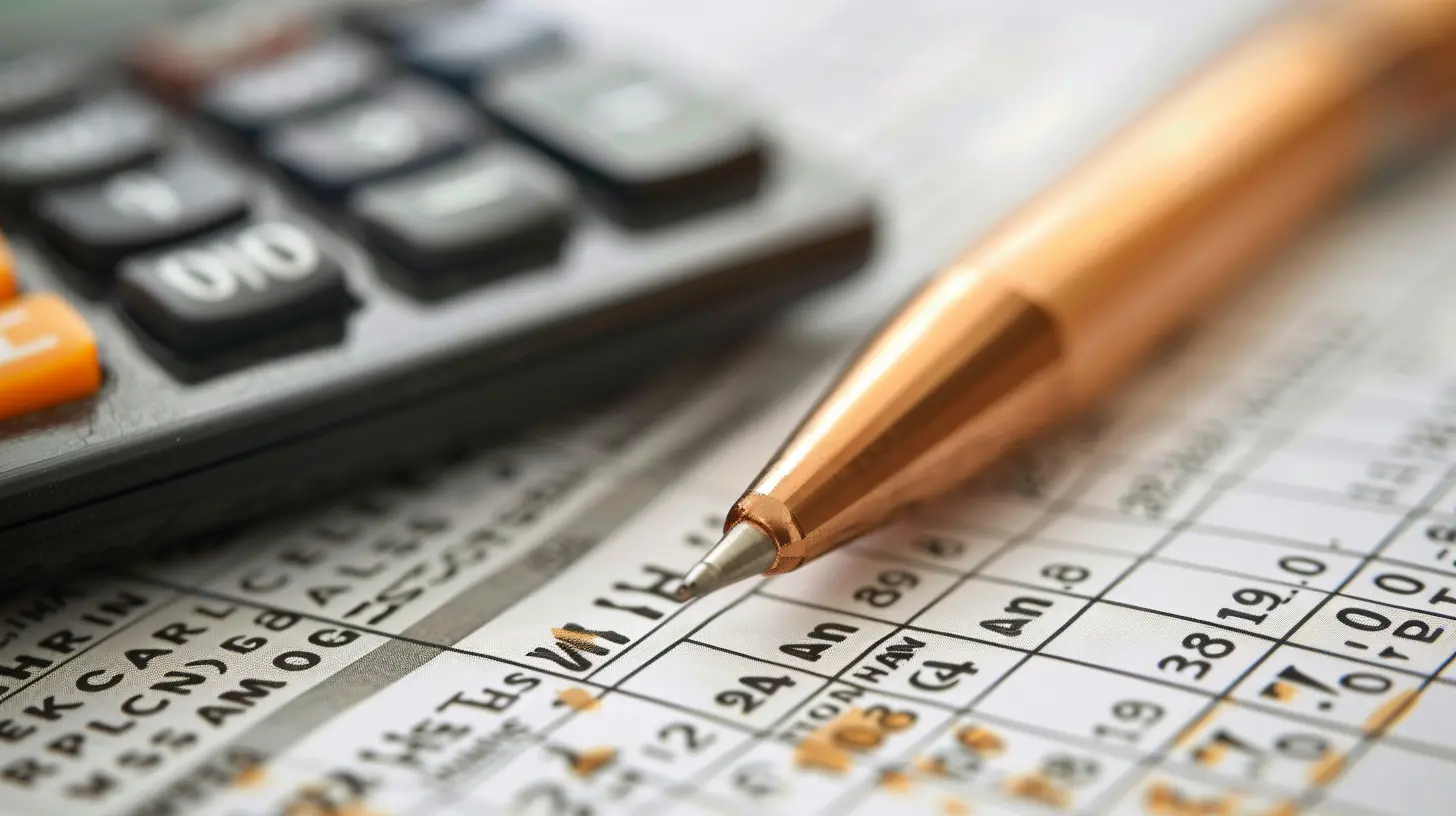Home Office Deduction: What You Can and Can’t Write Off
8 July 2025
Let’s be honest—the work-from-home lifestyle has its perks. Pajamas all day? Yes, please. Ditching the daily commute? Sign me up. But when tax season rolls around, that home office starts looking like an opportunity to trim your tax bill.
The good news? You might qualify for a home office deduction. The not-so-good news? Uncle Sam has rules—those classic, confusing, fine-print rules that make your head hurt. But don't worry, we're going to break it all down in simple English.
In this guide, we’re going to cover what you can and can’t write off when it comes to your home office. We'll keep it fun, friendly, and totally digestible so by the end, you'll feel like a mini-tax expert (without needing a degree in accounting).
What Is the Home Office Deduction?
Let’s start at square one. The home office deduction allows you to write off certain expenses if you use part of your home exclusively and regularly for business. Yep, that’s the catch—you can’t just toss your laptop on the couch, take a Zoom call once a week, and call it a day.Who Qualifies?
To qualify for this deduction, your setup needs to fit into one of these categories:- Self-employed? You're in luck. Freelancers, gig workers, and small business owners can often deduct home office expenses.
- Remote employee? Sorry, you’re mostly out of luck. Since the Tax Cuts and Jobs Act of 2017, W-2 employees can’t claim this deduction—even if your boss made you work remotely.
So, if you’re running a side hustle from your spare bedroom or designing logos from your kitchen table full-time, keep reading.
The “Exclusive and Regular Use” Rule
Here’s where it gets serious. The IRS doesn’t play around with the word “exclusive.” Your home office must be used only for business. Not for Netflix binges. Not for Saturday scrapbooking. Business only.And “regular” use matters too. Occasional work-from-home sessions? Doesn’t cut it.
Think of it like this:
- Qualifies: A spare bedroom turned into a dedicated workspace where you take client calls and manage your Etsy shop.- Doesn’t qualify: Your dining room table that moonlights as a makeshift desk when you aren't eating dinner.

Two Ways to Claim the Deduction
Here’s where it gets juicy. You have two options for calculating your deduction:1. The Simplified Option
Easy-peasy. No need to keep receipts or dive into spreadsheets. Here's how it works:- Deduct $5 per square foot of your home office.
- The max you can claim is 300 square feet.
- That means the biggest deduction you can take is $1,500.
This method is great if you want something quick and low-maintenance.
2. The Regular Method
Get ready to channel your inner accountant. This method is more accurate and might save you more money, but it takes a little number crunching.- You’ll calculate the actual expenses of maintaining your home (mortgage interest, rent, utilities, repairs, etc.).
- Then, apply the percentage of your home used for business.
For example, if your home office takes up 10% of your home’s square footage, you can deduct 10% of qualifying home expenses.
What You CAN Write Off
Okay, now we’re talking. Let’s get into the good stuff—the tax-deductible goodies. If you qualify, here’s what you can write off using the regular method.1. Rent or Mortgage Interest
You can’t deduct the full amount of your rent or mortgage, but you can deduct the business-use portion.> For example: If your home office is 15% of your home’s size, you can deduct 15% of your rent or mortgage interest.
Note: Mortgage principal payments don’t count. Just the interest does.
2. Utilities
Gas, electricity, water, internet, and trash collection? If you need it to keep your business space functional, it’s probably deductible.Of course, you can only deduct the portion that relates to your office.
3. Homeowner’s or Renter’s Insurance
A portion of your home insurance—based on your office size—can be deducted.4. Repairs and Maintenance
Did you fix that squeaky office door or repaint the walls to look more professional on Zoom? You can write off repairs directly related to your home office.General repairs (like fixing a leaky roof) are partially deductible based on your office's square footage.
5. Depreciation
If you own your home, you can claim a depreciation deduction for the part used as an office. This gets a bit tricky though, so you may want to talk to a tax pro for this one.6. Office Supplies
Printer paper, pens, folders, sticky notes—if it helps you run your business, it’s probably deductible.Just keep those receipts. The IRS loves receipts.
7. Office Equipment & Furniture
Desks, chairs, monitors, printers—you name it. If you bought equipment exclusively for your business, that’s a write-off.Expensive gear? You may have to depreciate it over several years rather than deduct the full cost in one year.
8. Phone Line (Sort of)
You can’t deduct the base cost of your first phone line (even if you use it for business). But if you have a second line exclusively for business or use your cell phone significantly for work, you can generally deduct the business-use percentage.What You CAN’T Write Off
Now, don’t go crazy and try to deduct your entire grocery bill or Netflix subscription. The IRS has a pretty strict line between business and personal expenses. Here’s what you can’t deduct:1. Your Whole Home
Sorry, folks. Only the portion used exclusively for business counts.2. Personal Expenses
This includes things like:- Your Netflix or Hulu subscription (even if you “research storytelling”).
- Personal groceries (yes, even coffee).
- Family room furniture.
- Gym memberships.
If it’s not directly tied to business, it's off the table.
3. Non-Exclusive Spaces
Using your bedroom, kitchen, or living room as a part-time office? If it's not dedicated space, the deduction doesn’t fly.4. Office Clothing
Yes, even if you bought a whole wardrobe for video calls. The IRS considers clothing that can be worn outside of work non-deductible. Uniforms? Sometimes. Pajamas and polos? Sorry.Common Mistakes to Avoid
The home office deduction sounds great, but it comes with some easy-to-miss pitfalls. Here are classic slip-ups you’ll want to avoid:❌ Overestimating Your Office Area
Don't “guesstimate” your office size. Measure it. The IRS is picky, and rounding up won’t do you any favors.❌ Mixing Personal and Business Expenses
Keep things separate. Open a business bank account. Use different cards. Keep detailed records. Believe me, it'll save you a massive headache if the IRS ever asks you to prove your case.❌ Forgetting the Exclusive Use Rule
We’ve said it before, but it bears repeating—exclusive use is non-negotiable. Don’t try to sneak in a dual-purpose room unless you want trouble.Tips to Maximize Your Deduction
Want to squeeze every last dollar out of your home office deduction? Here’s how:✅ Keep Killer Records
Receipts, bills, floor plans—file it all. Use apps or software to track expenses throughout the year. Don’t wait until April to scramble.✅ Take Photos of Your Office
A little visual proof doesn’t hurt, especially if you're ever audited. Just snap some pics showing your space is truly used for work.✅ Consider the Simplified Option
If you’re overwhelmed by receipts or your office is small, the simplified method might save your sanity (and time).Final Thoughts: Is It Worth It?
Absolutely—if you qualify. The home office deduction can put real cash back in your pocket, especially for freelancers, solopreneurs, and small business owners hustling from home.But remember: the IRS plays it tight when it comes to this one. So be honest, be precise, and keep things clean.
If you’re ever unsure, talking to a tax professional is a smart move. It’s better to be safe than to get that dreaded audit letter in the mail.
And hey, next time you're sipping coffee at your desk in bunny slippers while writing off 10% of your electricity bill—give yourself a pat on the back. You’re leveling up your money game.
all images in this post were generated using AI tools
Category:
Tax DeductionsAuthor:

Julia Phillips
Discussion
rate this article
1 comments
Cara McLanahan
Great insights on the home office deduction! It’s so important to understand what qualifies and what doesn’t. Your tips really help simplify the process. Looking forward to maximizing my home office deductions this year—thanks for sharing this valuable info!
July 23, 2025 at 11:36 AM

Julia Phillips
Thank you for your kind words! I'm glad you found the tips helpful. Best of luck maximizing your deductions this year!


